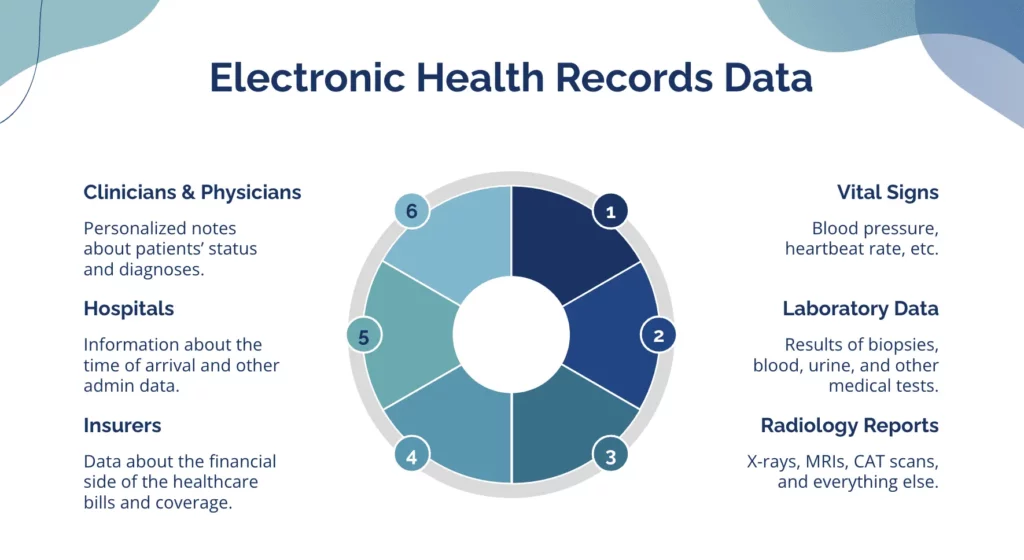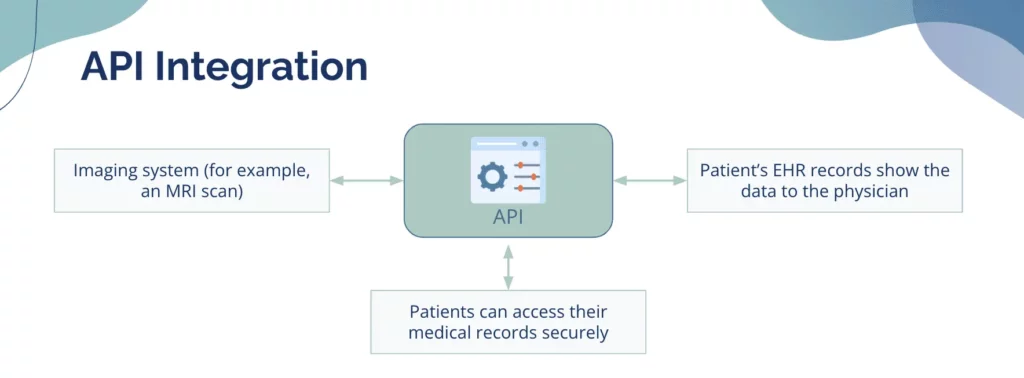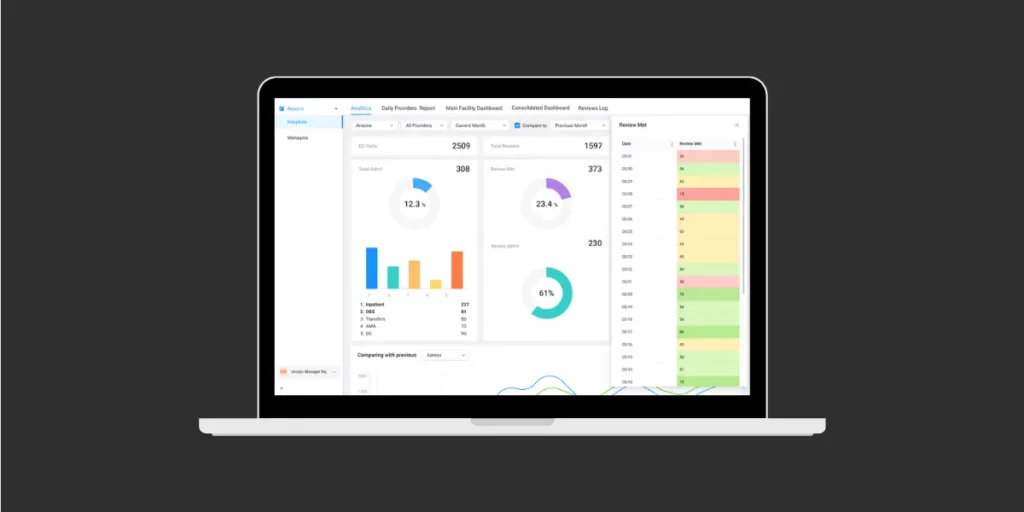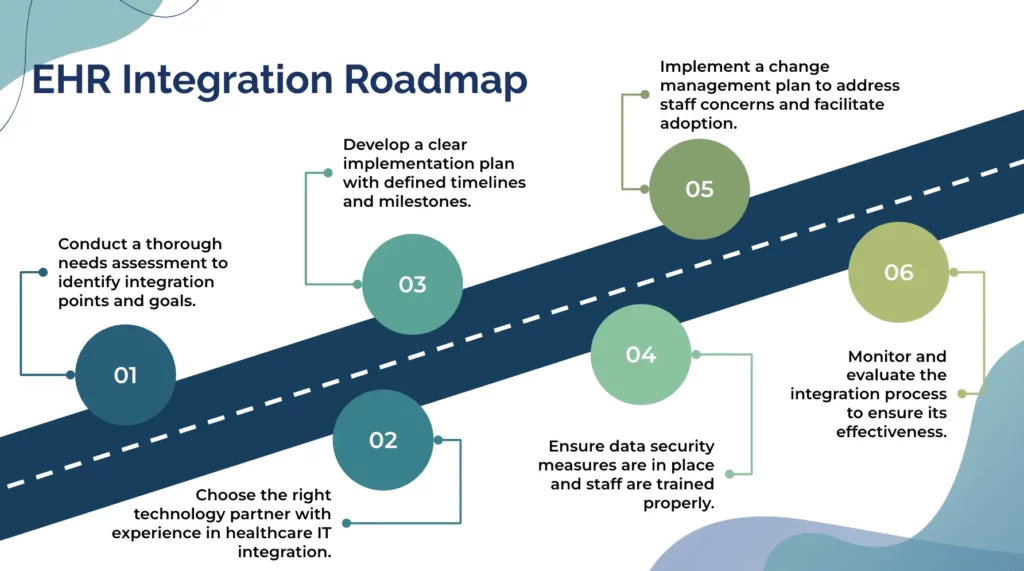The rise of Electronic Health Records (EHRs) has revolutionized healthcare data management. Nearly 96% of non-federal acute care hospitals in the US have adopted certified EHR systems. At the same time, a recent study revealed that 72% of healthcare providers reported difficulty accessing complete patient data due to incompatible systems. This lack of seamless integration hinders informed care decisions, creates inefficiencies, and ultimately impacts patient outcomes.
The vast majority of non-federal hospitals have adopted certified EHR systems.
72% of healthcare providers struggle to access patient data due to incompatible systems.
The growing adoption of EHRs has created a new challenge – fragmented healthcare systems. Hospitals, clinics, and specialists often utilize different software, leading to isolated data silos. This lack of seamless integration makes accessing a patient’s complete medical picture difficult, hindering informed care decisions, and creating inefficiencies.
EHR integration bridges this gap by connecting disparate healthcare systems. Imagine a single, unified platform where all patient data flows freely. This integration unlocks a range of potential benefits, including improved patient care, increased workflow efficiency, and valuable data insights.
Let’s delve deeper into how EHR integration can transform healthcare data management.

Understanding EHR Integration: Eliminating the need for manual data entry
EHR integration refers to the process of connecting disparate healthcare information systems to enable the seamless exchange of patient data.
Imagine a hospital where a patient’s lab results from an external lab automatically populate their EHR, eliminating the need for manual data entry. This is the power of EHR integration.
Different types of EHR integration achieve this seamless data flow:
Bi-directional Data Exchange:
This is the most robust form of integration, allowing for two-way communication between systems. Data flows freely in both directions, ensuring both source and destination systems have the most up-to-date information.
For instance, changes made to a patient’s medication list in the EHR can be automatically reflected in the pharmacy system.

Point-to-Point Integration:
This establishes a connection between two specific systems. Data is transferred directly between those designated points, offering a targeted approach.
An example might be integrating an imaging system with the EHR, allowing doctors to view diagnostic images directly within the patient’s electronic record.

API Integration:
APIs (Application Programming Interfaces) act as intermediaries between systems, facilitating data exchange through pre-defined protocols. This method allows for flexible integration with a broader range of healthcare systems, promoting wider data accessibility.
For instance, an API might connect a patient portal to the EHR, allowing patients to access their medical records securely.

Additional Considerations:
Standardized Data Formats: For seamless integration, data needs to be formatted in a way that different systems can understand. HL7 (Health Level Seven) is a common standard for healthcare data exchange.
Security Measures: Protecting sensitive patient data is paramount. Robust security protocols are essential for any type of EHR integration.
What data sources can you connect to the EHR?
EHR integration unlocks the power of a connected healthcare ecosystem, where patient data flows freely between various systems to provide a comprehensive view of their health. Here are some key data sources that can be integrated with an EHR to create a more holistic patient record:
EHR & Clinical Data:
- Laboratory Systems: Seamless integration with lab systems allows for the automatic transfer of test results directly into the EHR. This eliminates manual data entry errors and ensures doctors have the latest information for informed care decisions.
- Imaging Systems: Integration with radiology or imaging systems allows doctors to view X-rays, MRIs, and other diagnostic images directly within the EHR. This improves workflow efficiency and facilitates better collaboration between specialists.
- Pharmacy Systems: Integrating pharmacy systems with the EHR provides medication history, allergy information, and potential drug interactions, all readily accessible within the patient’s record. This promotes medication adherence and reduces the risk of adverse drug reactions.
- Dental Records: Integrating dental records can be particularly beneficial for patients with complex medical histories. It provides a complete picture of their health and allows for better coordination between healthcare providers.
- Nursing Documentation: Integrating nursing documentation systems allows for nurses’ notes, observations, and vital signs to be readily available for doctors within the EHR. This streamlines communication and enhances patient care coordination.
EHR and Patient-Generated Data:
- Patient Portals: Integrating patient portals allows patients to securely access their health information, including lab results, progress notes, and upcoming appointments. This empowers patients to take a more active role in their healthcare journey.
- Wearable Devices: Fitness trackers, smartwatches, and other wearable devices can be integrated with the EHR to capture real-time patient data (e.g., heart rate, blood pressure, activity levels). This data can provide valuable insights into a patient’s health and well-being.
- Telehealth Platforms: Integrating telehealth platforms with the EHR allows for seamless documentation and data transfer during virtual consultations. This ensures continuity of care between in-person and remote appointments.
Additional Data Sources:
- Social Determinants of Health (SDOH) Data: Integrating data on factors like income level, housing situation, and access to healthy food can provide valuable context for a patient’s health and inform social support interventions.
- Research Data: Integrating research databases can be beneficial for teaching hospitals or academic medical centers. It allows healthcare professionals to access relevant research findings and potentially contribute to ongoing studies.
This comprehensive data allows for improved clinical decision-making, enhanced patient care coordination, and, ultimately, better health outcomes.


Streamlining Utilization Reviews
The HIPAA-certified platform integrates seamlessly with Electronic Health Records (EHR) systems, ensuring efficient data exchange and eliminating the need for manual data entry.
Benefits of EHR Integration for Healthcare Organizations
Improved Patient Care
EHR integration empowers healthcare providers with a comprehensive view of their patients’ health. This centralized record, encompassing lab results, medications, and even patient-generated data, fosters well-informed care decisions.
Furthermore, seamless data exchange minimizes errors and streamlines medication management, contributing to improved patient safety. Integration can also extend to patient portals, fostering better communication and engagement, and empowering patients to actively participate in their healthcare journey.
Increased Efficiency
Streamlined workflows and reduced manual data entry free up valuable staff time for patient care. Improved communication and collaboration between departments, with everyone accessing the same real-time data, allows for smoother care coordination.
These efficiency improvements can even translate to cost savings, as resources are better utilized and redundancies are eliminated.
Enhanced Data Analytics
Integrating healthcare data through EHR integration unlocks a treasure trove of insights. This comprehensive data allows for powerful data analytics, enabling healthcare organizations to stratify patient risk and manage population health.
By analyzing integrated data, healthcare providers can identify patients at higher risk for developing certain conditions. This allows for proactive interventions and preventative care, potentially improving patient outcomes.
Going a step further, by analyzing data across patient populations, healthcare organizations can gain valuable insights into community health trends. This empowers them to develop targeted public health initiatives and resource allocation strategies for improved population health outcomes.
Challenges of EHR Integration and Considerations
| Data Security and Privacy | Patient privacy is paramount. EHR integration necessitates robust data security measures to safeguard sensitive health information. This includes implementing access controls, encryption protocols, and regular security audits. Compliance with HIPAA (Health Insurance Portability and Accountability Act) regulations is crucial to ensure patient data privacy and avoid potential legal ramifications. |
| System Compatibility | The dream of seamless data exchange can be hampered by system compatibility issues. Different healthcare systems may utilize proprietary formats or outdated technologies, creating hurdles for smooth integration. To overcome this challenge, thorough planning is essential. Carefully evaluate existing systems and assess their compatibility with potential integration solutions. Selecting the right vendor is also crucial. Look for partners with experience in healthcare IT integration and a proven track record of ensuring compatibility across diverse healthcare systems. |
| Change Management | EHR integration isn’t just about technology; it’s about people too. Implementing a new system can disrupt established workflows and raise concerns among staff. Therefore, successful integration hinges on effective change management. Training & Communication: Comprehensive training equips staff with the knowledge and skills to navigate the new integrated system. Clear and consistent communication throughout the process keeps everyone informed and reduces anxieties. Open communication channels also allow staff to voice concerns or suggest improvements. Addressing User Resistance: Change can be unsettling. Some staff may resist the new system, clinging to familiar routines. Acknowledge these concerns and address them head-on. Highlight the benefits of integration, provide ongoing support, and involve staff in the decision-making process whenever possible. This fosters a sense of ownership and encourages adoption. Clear Implementation Plan: A well-defined implementation plan provides a roadmap for the entire process. It outlines timelines, training schedules, and roles and responsibilities. This clarity helps minimize disruptions, fosters a sense of control, and ensures a smoother transition for everyone involved. |
Roadmap for Successful EHR Integration: A Step-by-Step Guide

EHR integration is a complex undertaking, but with a well-defined roadmap, the process can be smooth and successful. Here’s a breakdown of key steps:
Conduct a Thorough Needs Assessment: Before diving in, a comprehensive needs assessment is crucial. This involves analyzing existing workflows, identifying data sources that require integration, and determining the desired outcomes. This assessment forms the foundation for your integration strategy, ensuring it addresses your specific needs and goals.
Choose the Right Technology Partner: Selecting the right technology partner is paramount. Look for a vendor with extensive experience in healthcare IT integration. They should possess a deep understanding of healthcare data standards and security protocols. Evaluate their track record of successful EHR integrations and ensure their solutions align with your long-term goals.
Develop a Clear Implementation Plan: A detailed implementation plan acts as the blueprint for your integration journey. It should define timelines with clear milestones, outlining key phases of the project. Assign roles and responsibilities for each team member involved. This comprehensive plan provides a sense of direction, keeps everyone on the same page, and helps avoid potential roadblocks.
Prioritize Data Security and Staff Training: Robust data security measures are non-negotiable. Implement industry-standard security protocols like encryption and access controls to safeguard sensitive patient information. Compliance with HIPAA regulations is essential to ensure patient privacy and avoid legal repercussions. Additionally, providing comprehensive training equips staff with the knowledge and skills to navigate the new integrated system. This training fosters confidence and increases user adoption.
Implement a Change Management Plan: Change management is vital for successful integration. Develop a plan that addresses potential staff resistance through clear communication, ongoing support, and opportunities for staff feedback. Involving staff in the decision-making process whenever possible fosters a sense of ownership and encourages smoother adoption of the new system.
Monitor and Evaluate: Integration is an ongoing process. Continuously monitor the performance of the integrated system and gather feedback from staff. Evaluate the effectiveness of the integration in achieving your initial goals. This allows for adjustments and optimizations to ensure the system continues to meet the evolving needs of your healthcare organization.
So, in case you need EHR integration…
EHR integration unlocks a transformative potential for healthcare organizations. Creating a unified healthcare ecosystem empowers providers with a comprehensive view of patient health, facilitates better-informed care decisions, and minimizes errors. Furthermore, streamlined workflows, enhanced communication, and data-driven insights boost efficiency and contribute to improved patient outcomes.
Ready to harness the power of EHR integration for your organization? At HUSPI, we are experts in healthcare IT integration. We offer a comprehensive suite of solutions tailored to meet your specific needs: from needs assessment and vendor selection to implementation and ongoing support, our team guides you through every step of the integration journey.
Don’t wait to experience the transformative power of seamless EHR integration. Contact us today for a free consultation and learn how we can help you optimize healthcare delivery for your patients and clients.
Wondering about time-to-value?
Request a no-obligation discovery call and receive a preliminary estimate tailored to your KPIs.


